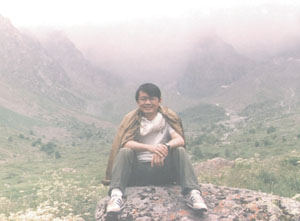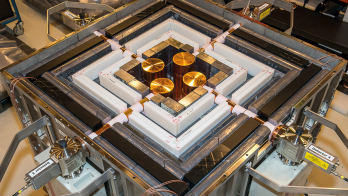Some 2000 metres underground in a working nickel mine, physicists have installed one of the world’s most sensitive instruments for observing the universe. Operational since 1999, the Sudbury Neutrino Observatory has ambitious plans for the future. James Gillies reports.

It all began 1.8 billion years ago when geologists believe that a meteorite struck the Earth, creating what is now the Sudbury basin in Canada. The impact allowed a rich seam of nickel-copper ore to rise through the Earth’s crust around the rim of the crater. Today the Sudbury basin is circled with the world’s largest concentration of nickel mines and in one of them, scientists accompany the miners on their morning descent to the 6800 ft (2000 m) level.
The Sudbury landscape still has an unearthly quality about it. Early mining efforts stripped away trees to provide fuel for smelting the ore, with the result that in the 1960s the Sudbury basin resembled a moonscape. NASA even sent moonshot astronauts there for training. Today the trees are coming back, thanks in part to the mines themselves, where underground nurseries provide warm stable conditions for trees to grow. “All you have to add is light,” said Art McDonald, director of the Sudbury Neutrino Observatory (SNO) as we stepped off the lift 2000 m underground. Here the rock is constantly at a temperature of 40°C, making for a sticky 1.5 km walk along the “SNO drift” – the tunnel connecting the mine shaft to SNO’s underground laboratory.
Cleanliness is the key
Visiting SNO is an adventure in itself. Scientists and miners are indistinguishable in all but their conversation as they descend in the lift. Overalls, miners’ lamps and safety harnesses are the order of the day. Everything to be taken into the lab must be carefully wrapped in plastic to protect it from the omnipresent mine dust. Arriving at the lab, boots are rinsed down, clothes are removed and everyone takes a shower before changing into a clean set of overalls and entering the lab.
Scrupulous attention to cleanliness is one of the keys to SNO’s success. Incredibly, the laboratory maintains class-100 clean-room conditions in the most sensitive areas and all areas are class-3000 or better. That means that everywhere within the laboratory there are fewer than 3000 particles of 1 µm or larger per 1 m3 of air. A typical room would give a count of around 100 000 particles and the SNO drift considerably more. Even more impressive is that these clean conditions were maintained throughout the construction of the experiment.
The emphasis on purity does not end with the air. Systems for purifying the SNO detector’s light and heavy water fill most of the available space. The 33 m deep, 22 m diameter chamber that houses the detector is lined with several layers of plastic material that help to keep the radiation level from uranium and thorium a full nine orders of magnitude lower than in the surrounding rock.
Herb Chen’s experiment

SNO began collecting data in 1999, but its history goes back much further. In 1984 Herb Chen of the University of California at Irvine first pointed out the advantages of using heavy water as a detector for solar neutrinos. Two reactions – one sensitive only to electron-type neutrinos, the other sensitive to all neutrino flavours – would allow such a detector to measure neutrino oscillations directly. The Creighton mine in Sudbury – among the deepest in the world – was quickly identified as an ideal place for Chen’s proposed experiment to be built and the SNO collaboration held its first meeting in 1984.
There were substantial obstacles to overcome before the experiment could be realized, not least of which was the cost of the heavy water. It was clear from the start that industrial partners would have to be found. INCO, the company operating the Creighton mine, became a key player, putting its infrastructure at SNO’s disposal and blasting out a new cavern for the experiment far away from ongoing mine activity. Another key partner was found in the form of Atomic Energy of Canada Limited, which provided C$330 million of heavy water on loan, free of charge. “In a sense we’re doing a greater than C$600 million project for less than C$100 million in terms of capital cost,” explained McDonald.
The experiment was approved in 1990. Excavation took three years and installation a further five. The detector consists of a 12 m diameter acrylic sphere containing 1000 tonnes of heavy water surrounded by light water and viewed by 10 000 photomultipliers. Filling the sphere with heavy water, flooding the cavern with light water and calibrating the detector was complete by November 1999, allowing data taking to begin.
In its first phase of running – to June 2001 – SNO’s analysis concentrated on the measurement of boron-8 electron neutrinos from the Sun. These are detected at SNO via the charged current process of electron neutrinos interacting with deuterons to produce two protons and an electron. First results published in 2001, taken together with Superkamiokande’s previous measurement (The Sudbury Neutrino Observatory confirms the oscillation picture) via the elastic scattering of boron-8 neutrinos from electrons with low sensitivity to neutrino types other than electron neutrinos, provide compelling evidence for neutrino oscillation.
The next step for SNO was to measure the total boron-8 neutrino flux to give a complete measurement that is independent of the Superkamiokande result. To do this, salt has been added to the heavy water. Salt increases SNO’s sensitivity to the flavour-blind process of neutral current neutrino-deuteron interactions, which are identified by the detection of the photon emitted when the deuteron’s neutron is captured. Capture on heavy water results in a 6.25 MeV photon, whereas capture on chlorine releases an 8.6 MeV photon that is more easily detected. Moreover, the neutron capture probability in SNO’s heavy water is around 25%, whereas in salt it rises to 85%. Radioactivity levels are also low for this phase of the experiment and data analysis is under way.
In a third phase of running, scheduled to begin in the second half of 2002, the salt will be removed and replaced by helium-3-filled proportional counters. These will give the experiment an independent sensitivity to the neutral current process and allow distortions in the solar boron-8 spectrum to be measured more accurately than before.
Supernovae warning
Solar neutrinos form just one strand of SNO’s research programme. The experiment’s ability to single out electron-neutrino interactions and its high sensitivity to other neutrino types gives it a powerful tool for investigating supernovae by observing the time development between different neutrino types emerging from the explosion. SNO’s data-acquisition system, normally running at around 10 Hz, is set up to buffer several hundred events in a window lasting just a few seconds if necessary, and it also alerts the shift crew whenever the event rate rises significantly. This initiates an analysis procedure, designed to identify whether noise or physics is responsible for the rise. SNO will be part of the Supernova Early Warning System (SNEWS) along with the LVD (Gran Sasso), Superkamiokande (Japan) and Amanda (South Pole) experiments. Signals sent to a central computer in Japan can be studied for time coincidences and the astronomical community can be alerted in the case of a supernova.
The neutrino burst can precede light by several hours. The detector’s location 2000 m below a flat surface also makes it a particularly powerful instrument for observing neutrinos created via cosmic-ray interactions in the atmosphere. In contrast with detectors under mountains, SNO has a 45° window for measuring downward-moving neutrinos. A clear distinction between downward and upward-moving neutrinos will allow SNO to make a model-independent measurement of atmospheric neutrinos over a three- to four-year timescale. SNO has a well defined programme until 2006 and ambitious plans thereafter. The scientists envisage a shift in emphasis towards more subtle neutrino physics and possible improvements to the SNO detector. Seasonal variations and correlations with the solar cycle are on the agenda. SNO will also turn its attention to other neutrino oscillation processes in the Sun.

Canadian scientists are hopeful of extending the laboratory beyond the one experiment that it currently houses. The Canadian government has recently launched the Canadian Foundation for Innovation International Programme to generate world-class international research facilities in Canada, and Sudbury is a strong contender. Having passed the first round of selection, the laboratory has been invited to submit a detailed proposal by February. Under this C$30 million plan, the Sudbury site would acquire a new experimental hall to house at least two new experiments. Final selection is scheduled for June 2002.
Herb Chen didn’t live to see his brainchild realized. He died in 1987, but his presence at Sudbury is still very strongly felt. Copies of his 1984 Physical Review Letters paper hang proudly around the laboratory and his portrait graces the entrance. SNO has put Sudbury firmly on the physics map, but it hasn’t lost sight of its roots. “The SNO team is working very hard to accomplish the full physics objectives while maintaining Herb’s memory as a constant inspiration,” explained McDonald.
Further reading
Herb Chen 1984 Phys. Rev. Lett. 55 14.
SNO Collaboration 2000 Nuclear Instruments and Methods A449 172-207.
SNO Collaboration 2001 Phys. Rev. Lett. 87 07301 1-6.








